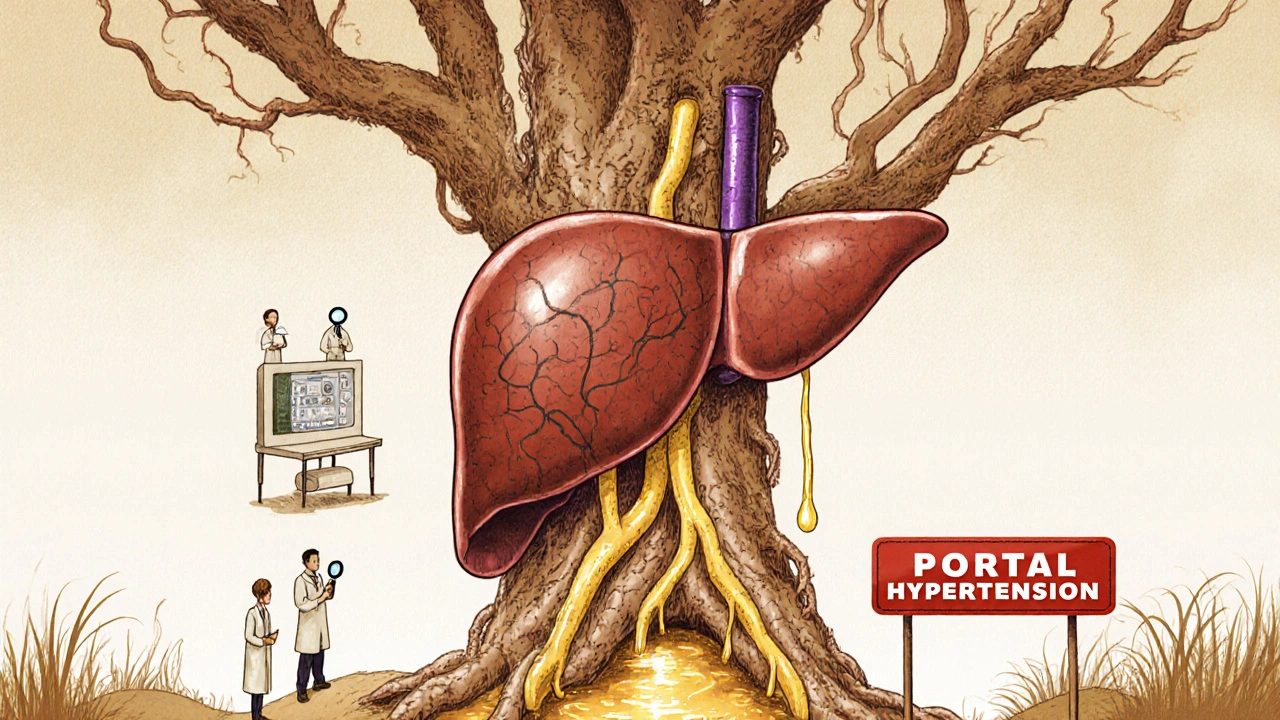
When your liver gets damaged over years-whether from alcohol, fat buildup, hepatitis, or other causes-it doesn’t just heal. It scars. That scarring is called cirrhosis. It’s not a single disease. It’s the final stage of chronic liver damage, where healthy tissue turns into stiff, tangled scar tissue. Blood can’t flow easily. The liver can’t filter toxins, make proteins, or store energy like it should. And once cirrhosis sets in, it’s permanent. But that doesn’t mean nothing can be done. Many people live for years with cirrhosis-if they catch complications early and manage them well.
What Happens When the Liver Starts to Fail?
Cirrhosis doesn’t always show symptoms at first. This is called compensated cirrhosis. You might feel tired, lose weight without trying, or bruise easily. These signs are easy to ignore. But as the liver gets worse, things shift fast. That’s when it becomes decompensated cirrhosis. This is when the real dangers show up. One of the first major red flags is fluid buildup in the belly-ascites. About half of people with cirrhosis develop this within 10 years. The liver stops making enough albumin, a protein that keeps fluid in the blood vessels. Without it, fluid leaks into the abdomen. This isn’t just uncomfortable-it’s dangerous. Fluid in the belly can get infected, leading to spontaneous bacterial peritonitis (SBP). Up to 30% of people with ascites get this infection, and it kills 1 in 4 patients during their first hospital stay. Another big problem is portal hypertension. This isn’t a disease itself-it’s high pressure in the vein that carries blood from your gut to your liver. When scar tissue blocks that flow, blood backs up. Veins in your esophagus and stomach swell up like balloons. These are varices. They’re thin-walled and can burst without warning. About 1 in 3 people with cirrhosis will bleed from varices at some point. Bleeding can be sudden and life-threatening. Even with treatment, 15-20% of people die during the first episode. Then there’s hepatic encephalopathy. Your liver normally clears ammonia and other toxins from your blood. When it fails, those toxins reach your brain. You might feel confused, forgetful, or sleepy. Your speech gets slurred. Your hands might shake. In severe cases, you can slip into a coma. This affects 30-45% of people with decompensated cirrhosis. It’s often called "brain fog," but it’s not just mental fatigue-it’s a medical emergency. And then there’s cancer. Cirrhosis is the biggest risk factor for hepatocellular carcinoma (HCC), the most common type of liver cancer. Between 2% and 8% of people with cirrhosis develop it every year. The good news? If caught early, it’s treatable. That’s why everyone with cirrhosis needs an ultrasound every 6 months. Without screening, tumors are often found too late.How Doctors Measure How Bad It Is
Not all cirrhosis is the same. Some people have mild damage and live for years. Others crash quickly. That’s why doctors use scoring systems to track severity. The Child-Pugh score looks at five things: bilirubin (a waste product), albumin (a protein), INR (a blood clotting test), ascites, and encephalopathy. Each gets a point value. Total score? Class A (5-6 points) means you’re doing okay-90% survive a year. Class C (10-15 points) means your liver is failing badly-only about half survive a year. But the most used score today is the MELD score. It’s based on three blood tests: bilirubin, creatinine (kidney function), and INR. Higher scores mean higher risk of death. A MELD score of 15 or above means you’re in serious danger. This score is used to prioritize who gets a liver transplant. But here’s the catch: some people with low MELD scores still have terrible quality of life. They’re confused all the time, can’t work, and are in and out of the hospital. That’s why new rules now include quality-of-life factors, not just lab numbers.How to Treat the Complications
Managing cirrhosis isn’t about curing it. It’s about stopping complications before they start-or catching them fast when they do. For ascites, the first step is salt. No more than 2 grams a day. That’s less than one teaspoon. Then come diuretics-spironolactone and furosemide. Most people respond well. But if fluid keeps coming back, you need a procedure called large-volume paracentesis, where doctors drain the fluid with a needle. For every liter removed, you need to get an IV of albumin. Without it, your blood pressure can crash. For varices, if you have medium or large ones, you’ll be put on a beta-blocker-like propranolol or nadolol. These lower pressure in the portal vein and cut bleeding risk by almost half. If you’ve already bled, you’ll get banding during an endoscopy. That’s when doctors use tiny rubber bands to tie off the swollen veins. You’ll need this done every few months until the veins are gone. For hepatic encephalopathy, lactulose is the go-to. It’s a sugar syrup that pulls toxins out of your gut. You take it 3 times a day. But it causes diarrhea-and lots of it. Many people say it ruins their social life. If lactulose isn’t enough, doctors add rifaximin, an antibiotic that doesn’t get absorbed. It cuts hospital visits by almost 60%. For liver cancer, surveillance is everything. An ultrasound every 6 months. If a tumor shows up, treatment options include surgery, ablation, or transplant. The earlier it’s caught, the better the chance. Screening finds early-stage tumors in 70% of patients who get checked regularly. Without it, that number drops to 30%.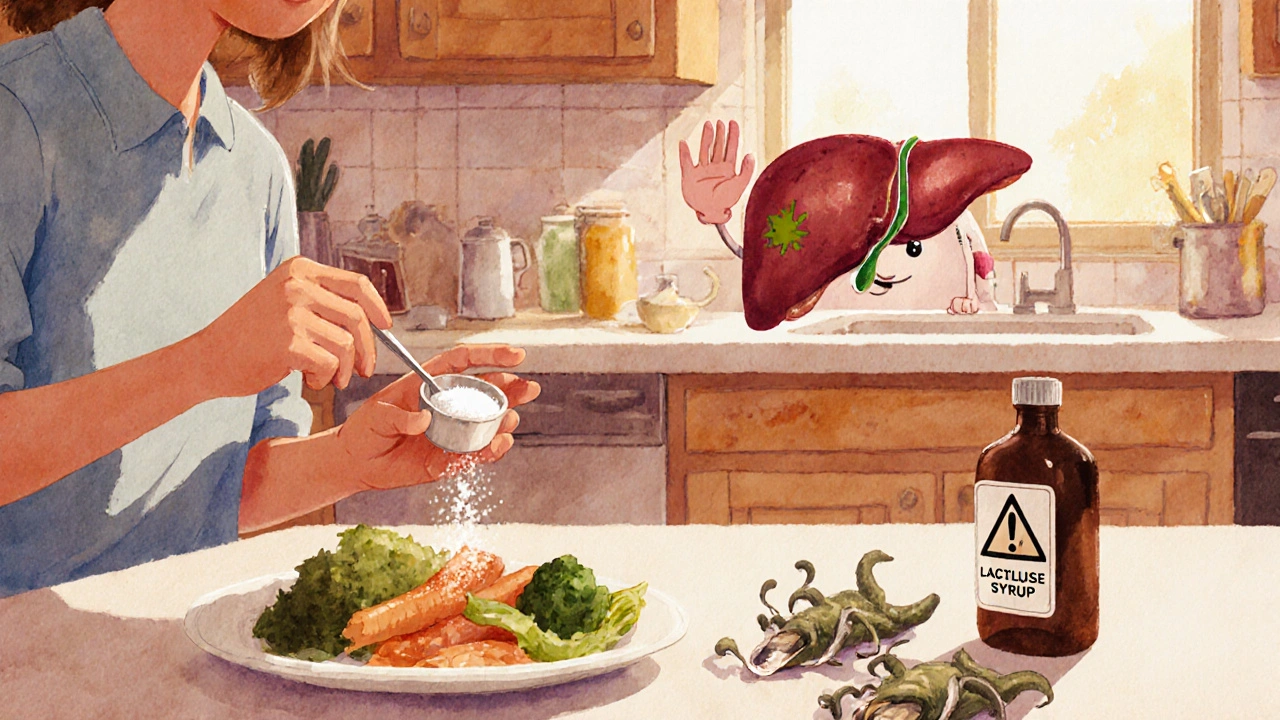
What You Can Do to Slow It Down
Medications help, but your choices matter more. If you drink alcohol-stop. No exceptions. Even small amounts can make cirrhosis worse. If you have hepatitis C, antiviral drugs like glecaprevir/pibrentasvir can cure it in 95% of cases. That doesn’t reverse scarring, but it stops further damage. If you have fatty liver disease (now called MASH), weight loss is key. Losing 7-10% of your body weight can improve liver health. New drugs like resmetirom (Rezdiffra) have been approved for MASH-related cirrhosis. In trials, it reduced liver scarring in over 20% of patients after one year. Eat right. Low salt. Enough protein (but not too much if you have encephalopathy). Avoid raw shellfish-it can cause deadly infections in people with liver disease. Get vaccinated. Hepatitis A and B can wreck a damaged liver. Make sure you’re protected.When Transplant Is the Only Option
For some, cirrhosis gets too far gone. When complications can’t be controlled, a liver transplant is the only lifeline. In 2022, over 8,000 liver transplants were done in the U.S. But there were more than 11,000 people waiting. About 1 in 8 people on the list die before getting a new liver. Transplant isn’t a cure-all. You’ll need lifelong medications to stop rejection. But for many, it’s a second chance. One patient said: "18 months post-transplant, my MELD score dropped from 28 to 9. I went back to work." The rules for who gets a transplant are changing. Instead of just using MELD scores, centers now look at how sick you feel-your energy, your mental clarity, your ability to care for yourself. This matters because a person with low MELD but constant confusion may be just as desperate as someone with a high score.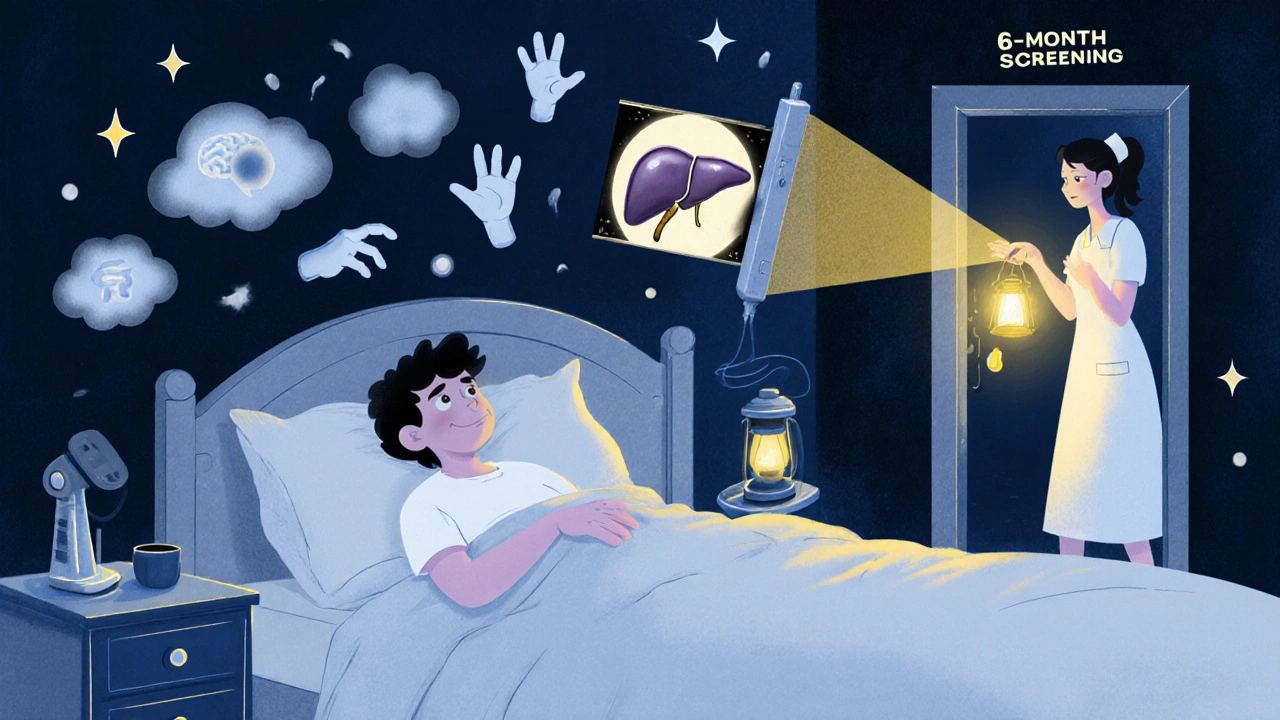
What Really Matters in Daily Life
Cirrhosis isn’t just a medical condition. It’s a life-altering one. People report crushing fatigue. 78% say it stops them from doing everyday things. Brain fog makes it hard to focus at work. Many quit their jobs. Others feel isolated because they can’t go out-too tired, too embarrassed by the swelling, too scared of infection. The cost is heavy. Rifaximin costs $1,200 a month without insurance. A transplant? Around $800,000. Medicare covers 80%, but the rest adds up fast. The best outcomes come from teams-not just hepatologists, but dietitians, social workers, addiction counselors, and nurse practitioners who check in daily. One study showed structured care improved medication adherence from 62% to 85%. ER visits dropped by 40%. You’re not alone. But you have to speak up. Ask for help. Ask about support groups. Ask about telehealth check-ins. Ask if you qualify for transplant evaluation. Don’t wait until you’re in the hospital to start the conversation.What’s Coming Next
The future is changing fast. AI tools like "CirrhoPredict" are being tested. They use simple lab results to guess who’s about to crash-weeks before symptoms show. That could mean early interventions, fewer hospital stays. New drugs are in trials. Galectin-3 inhibitors have shown promise in reversing early scarring. By 2030, experts think we’ll have treatments that can reverse cirrhosis in 40% of patients. We’re moving away from "one-size-fits-all" care. Your liver disease isn’t just about your lab numbers. It’s about your life. And that’s what treatment should be about.Can cirrhosis be reversed?
Cirrhosis itself-meaning the scar tissue-is permanent. But if you stop the cause (like alcohol or hepatitis), you can prevent it from getting worse. In some cases, especially with early cirrhosis and MASH, new drugs and weight loss can reduce scarring. Studies show up to 18% of patients can see fibrosis improve. The goal isn’t to erase the scars-it’s to stop them from spreading and let the liver heal around them.
Is it safe to take over-the-counter painkillers with cirrhosis?
No. Acetaminophen (Tylenol) is okay in small doses-no more than 2 grams a day. But NSAIDs like ibuprofen or naproxen are dangerous. They can cause kidney damage and make ascites worse. Always check with your doctor before taking any new medicine, even if it’s sold without a prescription.
Why do I need an endoscopy if I don’t have symptoms?
Varices don’t cause pain until they bleed. By the time you feel something, it could be too late. Endoscopy finds swollen veins before they rupture. It’s a quick, safe procedure. If you have cirrhosis, you should get one when diagnosed-and then every 1-2 years, or more often if you have large varices.
Can I still work with cirrhosis?
Many people do, especially in the compensated stage. But fatigue and brain fog can make it hard. If you’re struggling, talk to your doctor about accommodations. Some people switch to part-time work, work from home, or apply for disability. Your liver disease is a medical condition-and you have rights to support.
What should I do if I start feeling confused or sleepy?
That’s a red flag for hepatic encephalopathy. Stop eating protein for now. Take your lactulose right away. Call your doctor or go to the ER. Don’t wait. This can get worse fast. Early treatment can reverse it. Delayed care can lead to coma or death.
How often do I need to see my liver specialist?
If your cirrhosis is stable (compensated), you should see your hepatologist every 3-6 months. If you’ve had complications-like ascites, bleeding, or encephalopathy-you need to be seen every month. That’s when you’re most at risk. Regular visits mean problems are caught early, before you end up in the hospital.
Are there any foods I should avoid completely?
Yes. Raw or undercooked shellfish-like oysters or clams-can carry a bacteria called Vibrio vulnificus. It causes severe, often fatal infections in people with cirrhosis. Also avoid alcohol completely. Limit salt to under 2 grams a day. And don’t take herbal supplements without checking with your doctor-they can damage your liver.





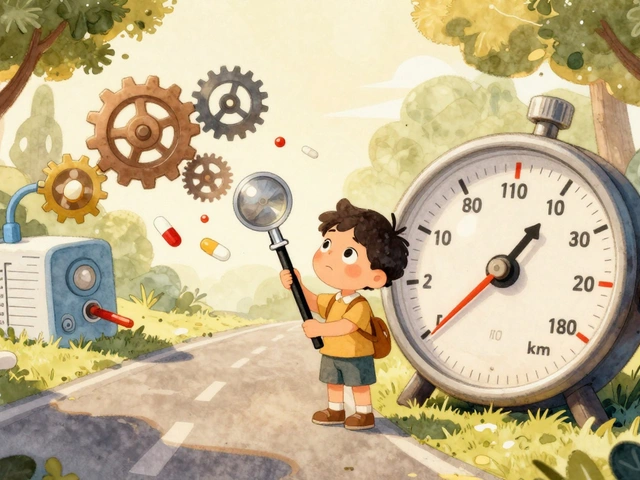
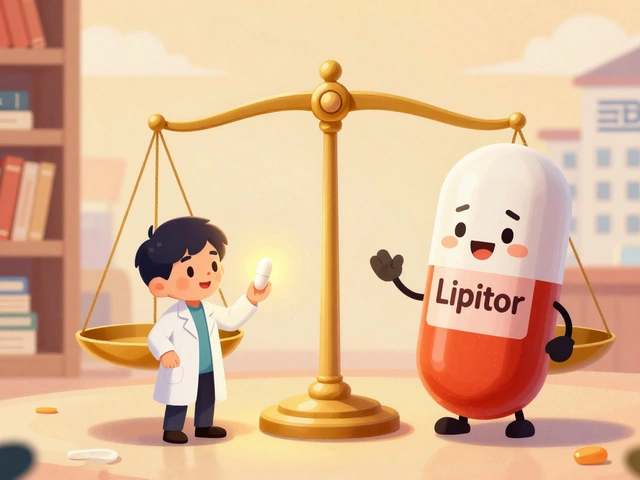
Reema Al-Zaheri
November 19, 2025 AT 03:58Cirrhosis is not a diagnosis-it’s a continuum of failure. The real tragedy isn’t the scar tissue; it’s that we treat it like a static condition when it’s a dynamic collapse of homeostasis. Ascites isn’t just fluid-it’s a biomarker of systemic endothelial dysfunction. Portal hypertension isn’t a lab value-it’s a silent storm in the splanchnic circulation. And yet, we still rely on Child-Pugh, a 1973 metric, to decide who lives or dies. We need dynamic, real-time biomarkers-not static scores. The MELD-Na is a step, but it’s still reactive, not predictive.
Michael Salmon
November 19, 2025 AT 05:26Let’s be real-most people with cirrhosis are just alcoholics who refused to quit. You don’t get to play the victim after 20 years of binge drinking and then expect the system to bail you out with a transplant. And don’t even get me started on the ‘fatty liver’ crowd-obesity is a choice. Stop blaming the liver and start blaming the fork. If you can’t control your eating or drinking, why should we waste a scarce organ on you?
Timothy Reed
November 20, 2025 AT 17:26While the medical details here are accurate, I’d like to emphasize the human side: cirrhosis doesn’t discriminate by income, education, or willpower. Many patients develop it after years of working multiple jobs without health insurance. Others inherited genetic risks masked by metabolic stress. The real breakthrough isn’t just in drugs like resmetirom-it’s in access. A patient in rural Alabama can’t get a MELD score evaluated if they can’t get to a hepatologist 100 miles away. Telehealth, community outreach, and nurse-led care coordination aren’t luxuries-they’re lifelines. Let’s not celebrate the science while ignoring the system that fails to deliver it.
Angela Gutschwager
November 22, 2025 AT 17:21So… I can’t have oysters. Got it. 😔
Andy Feltus
November 23, 2025 AT 09:24They say cirrhosis can’t be reversed. But here’s the twist: maybe it’s not the liver that needs healing-it’s the system that treats patients like broken machines. We give them diuretics and lactulose, but not therapy for the shame. We track MELD scores but ignore their ability to hold a job, hug their kids, or sleep without a swollen belly. The real innovation? Treating the person, not the pathology. If we could fix that, we wouldn’t need 8,000 transplants-we’d need 800.
Paige Lund
November 23, 2025 AT 12:37Why does every medical article have to be 5,000 words? I just wanted to know if I can still drink decaf coffee.
Kara Binning
November 24, 2025 AT 19:09THIS IS WHY AMERICA IS DYING. People are letting their bodies rot because they won’t stop eating pizza and drinking beer. And now the government is paying for their liver transplants with MY TAXES. I work 60 hours a week, eat kale, and run marathons-and I can’t even get a damn MRI for my knee. This is moral bankruptcy. Someone needs to shut this down.
river weiss
November 26, 2025 AT 13:03For those managing cirrhosis: adherence is everything. Lactulose isn’t pleasant-but skipping it increases encephalopathy risk by 300%. Beta-blockers reduce variceal bleeding by 45-50%. These aren’t suggestions; they’re survival protocols. If you’re struggling with cost, ask your clinic about patient assistance programs-many pharmaceutical companies offer them. And if you’re feeling isolated, reach out to the American Liver Foundation. They have peer mentors who’ve been there. You’re not alone, but you are responsible-for your health, and for your future.
Brian Rono
November 26, 2025 AT 18:18Let’s not sugarcoat this: cirrhosis is the slow-motion suicide of the American dream. You want to live? Stop being a walking fast-food commercial. You want to avoid transplant? Stop treating your liver like a trash compactor. And for God’s sake, stop Googling ‘natural liver cleanses’-that’s not medicine, that’s snake oil with a yoga mat. The science is clear: alcohol, sugar, and ignorance are the triumvirate of liver death. Fix your life-or fix your will to die. No one else is going to do it for you.